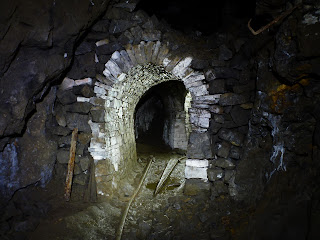Brownley Hill mine was first worked for lead with silver being extracted as well, the earliest workings being via surface shafts on the Brownley Hill Vein. Records dated 1735 from the Greenwich Hospital indicate that the mine was of no real economic value at this time. In the middle of the 1700's the London Lead Company took out a lease for just under 20 years. They worked the Brownley Hill Vein in the Little Limestone and in the hazles above it, obtaining a considerable amount of ore, but they were prevented from mining deeper by water. To overcome the problem they drove the Brownley Hill High Level in the sills above the Great Limestone in an attempt to reach the Little Limestone gaining access to the bottom of old workings, however only a fraction of the expected ore was found. The company also tried the Brownley Hill Moss Cross Vein and Jug Vein, but due to poor ventilation they abandoned their undertakings in this area. In all, they gave up their lease before it was expired as the total current outlay on development brought forth very little in results.
At the end of 1765 a new lease was taken out by two man team who obtained a very large amount of ore from the cross Veins as well as the Brownley Hill Vein. The ore raised was sold to the London Lead Company. In 1795 the lease passed to the newly formed Brownley Hill Lead Company. This was a particular lucrative time as the price of lead increased dramatically due to the wars with France. When the price declined again the lease was sold on to another group in 1816, which continued to work the mine under the same name of the Brownley Hill Lead Company. The mine now was being worked for zinc as well lead. It is during this period that the mine started to really develop. The Bloomsberry Horse Level was driven and the previously worked veins were now being worked from below. The horse level extended out on Guddamgill Cross Vein, Wellgill Cross Vein, Brownley Hill North Vein, Brownley Hill Vein eventually reaching the Brownley Hill Moss Cross and Brownley Hill High Cross Veins as well as Jug Vein. The lead ore in the lower levels were much poorer than that obtained in the higher horizons, however the grade of zinc ore was very good and this contributed to the operations profitability. Production was maintained until the middle of the 1850's.
In 1869 the mine was operating under a different concern again, the Brownley Hill Lead Mining Company during this period the mine was closed for a while and then reopened again with the same workforce. In 1890 the company sold up the complete mining operation to the Nenthead and Tynedale Lead and Zinc Company who held the lease until 1894. At this time high grade lead ore was depleted and the Vieille Montagne Zinc Company took over the lease in 1914 shifting operations to the extraction of zinc ore. The mine operated until 1936. The last working of the mine was between 1964 and 1966; when the trial Slate Sill level was driven in the Slate Sills southeast of the Brownley Hill Moss Cross Vein.
At the end of 1765 a new lease was taken out by two man team who obtained a very large amount of ore from the cross Veins as well as the Brownley Hill Vein. The ore raised was sold to the London Lead Company. In 1795 the lease passed to the newly formed Brownley Hill Lead Company. This was a particular lucrative time as the price of lead increased dramatically due to the wars with France. When the price declined again the lease was sold on to another group in 1816, which continued to work the mine under the same name of the Brownley Hill Lead Company. The mine now was being worked for zinc as well lead. It is during this period that the mine started to really develop. The Bloomsberry Horse Level was driven and the previously worked veins were now being worked from below. The horse level extended out on Guddamgill Cross Vein, Wellgill Cross Vein, Brownley Hill North Vein, Brownley Hill Vein eventually reaching the Brownley Hill Moss Cross and Brownley Hill High Cross Veins as well as Jug Vein. The lead ore in the lower levels were much poorer than that obtained in the higher horizons, however the grade of zinc ore was very good and this contributed to the operations profitability. Production was maintained until the middle of the 1850's.
In 1869 the mine was operating under a different concern again, the Brownley Hill Lead Mining Company during this period the mine was closed for a while and then reopened again with the same workforce. In 1890 the company sold up the complete mining operation to the Nenthead and Tynedale Lead and Zinc Company who held the lease until 1894. At this time high grade lead ore was depleted and the Vieille Montagne Zinc Company took over the lease in 1914 shifting operations to the extraction of zinc ore. The mine operated until 1936. The last working of the mine was between 1964 and 1966; when the trial Slate Sill level was driven in the Slate Sills southeast of the Brownley Hill Moss Cross Vein.













No comments:
Post a Comment